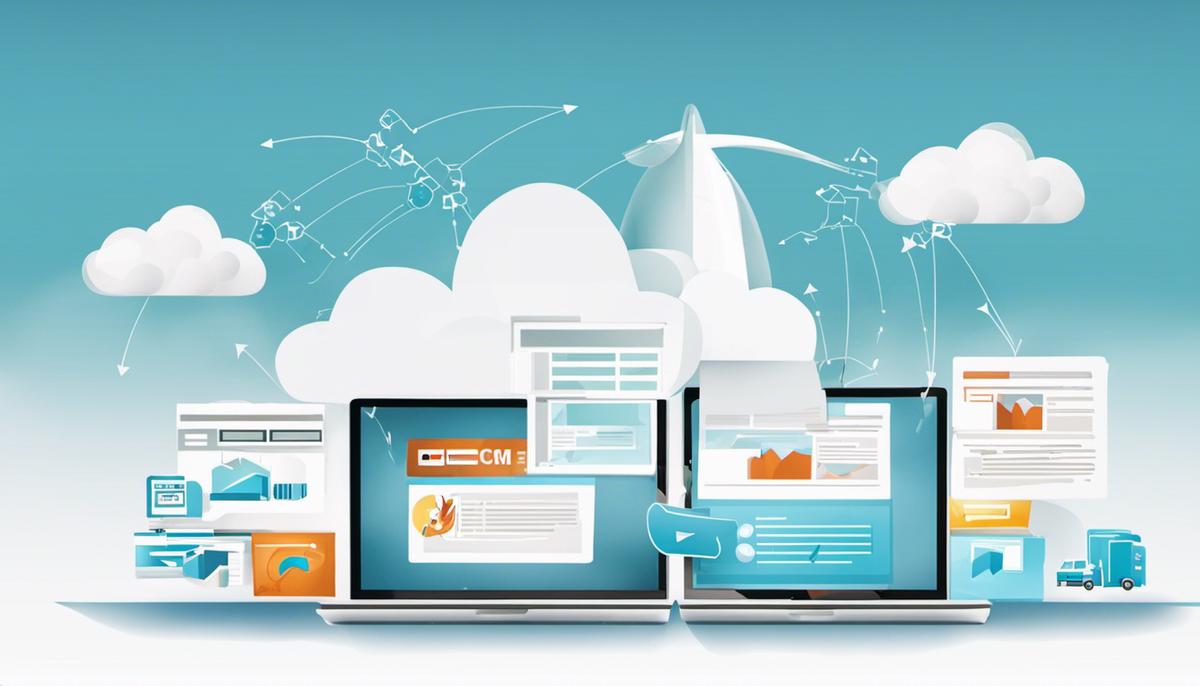As the digital age continues to evolve, it has become almost imperative for businesses to keep up with the cutting-edge technological advancements. One such innovation is Cloud-Based CMS (Content Management System), a game-changing instrument with limitless potentials that is radically transforming the face of content management. From small businesses to multinational corporations, the scalable, accessible and collaborative nature of Cloud-Based CMS is superseding traditional systems, enhancing workflows, and propelling greater corporate growth. This discourse seeks to offer an in-depth analysis into the world of Cloud-Based CMS – its fundamental concepts, salient features, the systematic approach to its selection, the process of implementation and the foreseeable future trends in this ever-evolving technological sphere.
Understanding Cloud-based CMS
When it comes to addressing the challenges of traditional content management systems (CMS), cloud-based CMS offers a fresh, revolutionary approach. A fundamental shift from traditional CMS, a cloud-based CMS can streamline content management while improving efficiency, accessibility, and cost-effectiveness. Let’s dive deeper to understand why cloud-based CMS is a real game-changer.
First and foremost, a flawless content operation hinges on accessibility. Traditional CMS often restricts access to in-house systems, requiring the team to be onsite, which is not always feasible. Cloud-based CMS is a breath of fresh air, offering unlimited access from any device, any location, as long as there’s Internet connectivity. Say goodbye to on-premise infrastructural dependencies.
Next up on the list of cloud CMS’s advantages is its scalability. As needs evolve, the traditional CMS can stumble, leaving room for latency, system overload and ultimately, a compromised user experience. Cloud CMS, on the other hand, leverages the power of cloud computing to scale resources instantaneously, ensuring smooth and uninterrupted performance no matter the volume of traffic or content. The elasticity of cloud systems is a blessing in the fast-paced digital world.
Even when it comes to updates and maintenance, cloud-based CMS steals a march over its traditional counterpart. Traditional CMS often requires manual updates and patches, leading to operational downtime. But with a cloud-based CMS, updates are seamlessly taken care of by the provider, with minimal to no downtime, thus optimizing workflows and productivity.
Security is another mainstay where cloud CMS excels. Traditional CMS are more vulnerable, getting exposed to security risks as the on-premise systems might not always keep up with the latest security protocols and updates. Cloud-based CMS providers, however, have robust security mechanisms in place with regular updates and 24/7 surveillance of data centers, offering an additional layer of protection against cyber threats.
Let’s talk about cost-effectiveness. Traditional CMS requires significant upfront investment for hardware, software and ongoing maintenance requirements. Cloud CMS operates on a service model with flexible pay-as-you-go plans that considerably reduces upfront costs. It’s a valuable contributor to keeping budget strings tight while not compromising on quality.
Finally, cloud-based CMS demonstrates exceptional agility and speed when it comes to deployment. It takes much less time to implement than traditional CMS, meaning businesses can hit the ground running with content management in lesser time frames.
The technology world is always about pushing the boundaries, streamlining processes and about delivering better user experiences. Seeing the multitude of benefits, from accessibility, scalability, seamless updates to robust security and efficient cost-effectiveness, it’s no surprise that a cloud-based CMS has emerged as a potent game-changer in the content management domain. By embracing this innovation, businesses can unlock unprecedented potential encompassing productivity, user experience and beyond. It’s a crystal-clear instance of technology simplifying complex processes, and the tech enthusiasts couldn’t have asked for more.

Key Features of Cloud-Based CMS
The article continues:
Collaboration Efficiency
One imperative feature that positions cloud-based CMS in a unique spectrum is the facilitation of enhanced collaborative endeavors. Traditional CMS often limits users to work within the constraints of a single location, inhibiting collaboration and slowing down traffic flow. On the other hand, cloud-based CMS provides users with the leverage to work from anywhere, promoting fluid cross-team collaboration and seamless content management operations.
Multitenancy
In cloud-based CMS, the cornerstone of functionality is the multitenant architecture. This mechanism enables multiple users to use a single instance of software, running on a single server, while their data remains isolated and invisible to other tenants. The multitenant architecture does not just improve operational speed but also significantly lowers system management costs, bringing a perfect blend of performance optimization and economic efficiency.
User-Friendly Interface
As tech-savvy as one might be, a difficult-to-navigate interface can be a frustrating barrier in leveraging a technology’s full capacity. Here, cloud-based CMS earns brownie points with its user-friendly interface. It offers a modern, intuitive, and clean interface that’s easy to understand, eliminating the steep learning curve generally associated with new software adoption.
Downtime & Disaster Recovery
The robustness of a CMS not only lies in its features and user interface but also in its contingency measures to combat downtime events and disaster recovery. Cloud-based CMS has the advantage here also. They feature in-built disaster recovery solutions and promise minimal downtime, keeping your digital content accessible and data safe, even under uncertain circumstances.
Integration Capabilities
Given the diverse tools businesses use today, integration capabilities of a CMS can differentiate a headache from harmony. Cloud-based CMS juice its functionalities by offering seamless integration with a range of third-party applications and tools. Whether CRM or an analytics tool, it delivers seamless interoperability, allowing for efficient data flow and more unified business operations.
Indeed, the technology trend favoring cloud-based CMS brings a fitting line from Darwin’s theory to mind – it is not the most intellectual or strongest species that survives; it is the one that is most adaptable to change. As enterprises adapt to evolving digital landscapes, the adaptability of a cloud-based CMS makes it both an appealing and sensible choice.

Choosing the Right Cloud-Based CMS
It’s fantastic that already established key factors such as accessibility, scalability, updates and maintenance, security, cost-effectiveness, deployment agility, collaboration efficiency, multitenancy, user-friendly interface, downtime & disaster recovery and integration capabilities. Fortunately, there are other crucial aspects to consider while selecting a cloud-based CMS, and they include:
- Customization
- Analytical capability
- Vendor Credibility
- Technologies’ Future considerations
Customization is paramount in selecting the most suitable cloud-based CMS. Every business has its unique needs, and the selected system should be able to meet those needs. Ensure to choose a system that allows your business to personalize its functions to align with your organization’s requirements. It should allow for tweaks in content presentation, have flexible layouts, and enable necessary changes that embody the brand’s identity. This would provide an enjoyable experience for the end-users. After all, taking the user’s voice into account is a cornerstone of a thriving online presence.
Analytical capability is another critical feature not to be overlooked. Data-driven decisions are increasingly becoming the norm in all sectors, and your choice of a cloud-based CMS should enable this approach. Its in-built analytics should efficiently track and measure the performance of your content. The system must be able to provide insights regarding user behavior, traffic sources, time spent on your site, among other valuable metrics, significantly assisting in strategic decision-making for content optimization.
Vendor credibility is equally important. Tech enthusiasts are well aware that in the ever-evolving world of technology, the reputation and reliability of the vendor play a significant role in the long-term success of the chosen technology. Check for the vendor’s track record for system updates and how frequently they release new features. Their reputation in terms of customer support and their ability to resolve issues quickly could make a huge difference in your CMS operation.
Lastly, take into consideration the future of the technology. As an early adopter and tech enthusiast, you are well aware that technology is continuously evolving. Therefore, the chosen cloud-based CMS should be a part of this evolution and not be left behind. The software you choose today should be capable of accommodating the advancements of tomorrow. Whether it’s the introduction of new coding languages, advanced AI, or the wider adoption of voice search, will your chosen solution be able to adapt?
Failing to any side – cost, aesthetics, or simplicity – without considering all these aspects, one might end up in a pothole of disappointing technology. But, armed with this knowledge, all tech enthusiasts like us can make an informed decision to choose the best cloud-based CMS, ensuring a good balance between the past, present, and the future of technology. Be ready to take all these into account when next you are faced with the task of choosing a cloud-based CMS. Remember, the aim is always to choose a responsive, future-ready, and robust system that supports your business growth trajectory.

Photo by chuttersnap on Unsplash
Implementing Cloud-Based CMS
API-First Design and Continuous Delivery in Optimal Cloud-Based CMS Implementation
Selecting the optimal approach for implementing a cloud-based Content Management System (CMS) extends beyond ensuring simple usability. It must consider the capability of the system to support the efficient creation, management, and delivery of digital experiences. Two vital considerations in this dynamic are the API-first design and the provision of continuous delivery.
API-First Design
This design approach considers APIs an utmost priority in the application development process. It involves designing the API before beginning the development stages for the cloud-based CMS. The API-first design ensures the software is better integrated, highly flexible, and potentially can function with other future systems.
How does it work in a CMS? First, the API serves as an instruction manual for accessing and manipulating the data stored in the CMS. The CMS’s front and back ends are decoupled, making them independently scalable. Content can then be retrieved and displayed on any frontend using the API. This approach ensures the CMS can keep pace with the ever-evolving constellation of digital channels.
Continuous Delivery
In an ever-changing digital landscape, the ability to adapt quickly to new requirements or market conditions is paramount. The principle of continuous delivery follows this vein. Whether the need is for an updated site design, newly integrated functionality, or security patch, continuous delivery ensures that these changes can be tested and deployed rapidly without disrupting the user experience.
This becomes possible by maintaining a codebase that is always in a releasable state. The development team works in small, frequent iterations, often incorporating automated testing to identify any bugs or issues promptly. If any problem arises, changes can be rolled back with minimum impact on the entire system, ensuring business continuity.
Both an API-first design approach and continuous delivery are essential for a cloud-based CMS implementation. These aren’t just trends, they are becoming the standard in how successful companies manage their digital experiences. Through its inherent scalability and flexibility, a well-executed cloud-based CMS could provide seamless user experience and robust performance meeting the needs of both content creators and the end users. The future of tech is here – and with strategic implementation steps, it can be effectively harnessed. Remember, strategy and foresight will be the tickets to leveraging cloud-based CMS’s full potential.
In conclusion, the optimal implementation of a cloud-based CMS requires considering not only its current capabilities, but also its flexibility to embrace inevitable advancements. This idea is steeped in the very essence of elitist technology reality – constant evolution. So, let’s implement with foresight and leap ahead with technology.

Photo by anniespratt on Unsplash
Predictions & Trends in Cloud-Based CMS
Artificial Intelligence (AI) and Machine Learning in the Cloud-Centric CMS
Contextual technology that goes beyond keywords is rapidly turning into a future-focus of cloud-based CMS technology, powered by AI and machine learning. The capabilities of these technologies enable the CMS to understand the context of data and enhance the structuring of content. Semantic algorithms can assist in optimizing the content placement, layout, targeting, and personalization, thereby enhancing the effectiveness and efficiency of CMS platforms.
AI can also automate content categorization and tagging, eliminating human errors and sparing the valuable time that is otherwise spent on monotonous tasks. Machine learning, on the other hand, can analyze user behavior, preferences, and interactions to predict future behavior, aiding in crafting personalized user experiences.
Edge Computing & CMS
As the volumes of data grow exponentially, edge computing offers a viable solution for managing this surge for cloud-based CMS. Edge computing pushes the computation and data storage closer to the location where it’s needed, reducing latency and allowing data to be processed in real-time.
The convergence of edge computing and CMS could redefine how content is delivered and experiences are curated. Think, for instance, about content being adapted and delivered based on the real-time location of the user. The amalgamation of real-time data processing and intelligent content management could push personalization and user responsiveness to unrivalled heights.
Blockchain for Optimum Security and Transparency
Decentralization, increased security, and transparency have been virulent in the tech world, and cloud-based CMS is poised to adopt these traits, thanks to Blockchain. Concerns about data security and potential breaches can be mitigated as Blockchain technology allows CMS users to secure their data in an encrypted, decentralized ledger.
The transparency offered by Blockchain also allows for an auditable trail of all content updates and modifications – a valuable feature for regulatory or legal reasons. This could completely revolutionize content integrity and copyright protection in media and publishing industries.
Internet of Things (IoT) Infusion
The proliferation of IoT devices offers an abundant source of data that can be leveraged by CMS. Not only can CMS distribute data to IoT devices but it can also gather data from these devices, helping to fine-tune the content strategy. The synergy of CMS and IoT can open new avenues of customer insights, service improvement, and business expansion.
The future of cloud-based CMS is undoubtedly compelling and teems with opportunities. As businesses adapt to changing technologies, it’s only a matter of time before CMS follows suit. Leveraging these technologies offers a path towards an intelligent, secure, and user-centric CMS poised to tackle tomorrow’s digital ecosystem. Witnessing these ideas turn into reality is an exhilarating aspect of the tech evolution voyage.

As the world becomes more technologically-driven, the pertinence of staying abreast with the latest trends and adapting to these changes cannot be overemphasized. Cloud-Based CMS, with its enhanced versatility, automation capabilities, and potential for higher productivity, epitomizes this progressive leap towards a more efficient and effective work process. The journey towards understanding and implementing this technology may be intricate, but the promised benefits are far reaching – ushering in a future of content management that is more streamlined, more collaborative, and more attuned to the evolving needs of businesses. Together with the insights provided about the current trends and predictions, this discourse aims to help businesses navigate the transformative wave of technology with an informed, progressive and adaptable approach.






